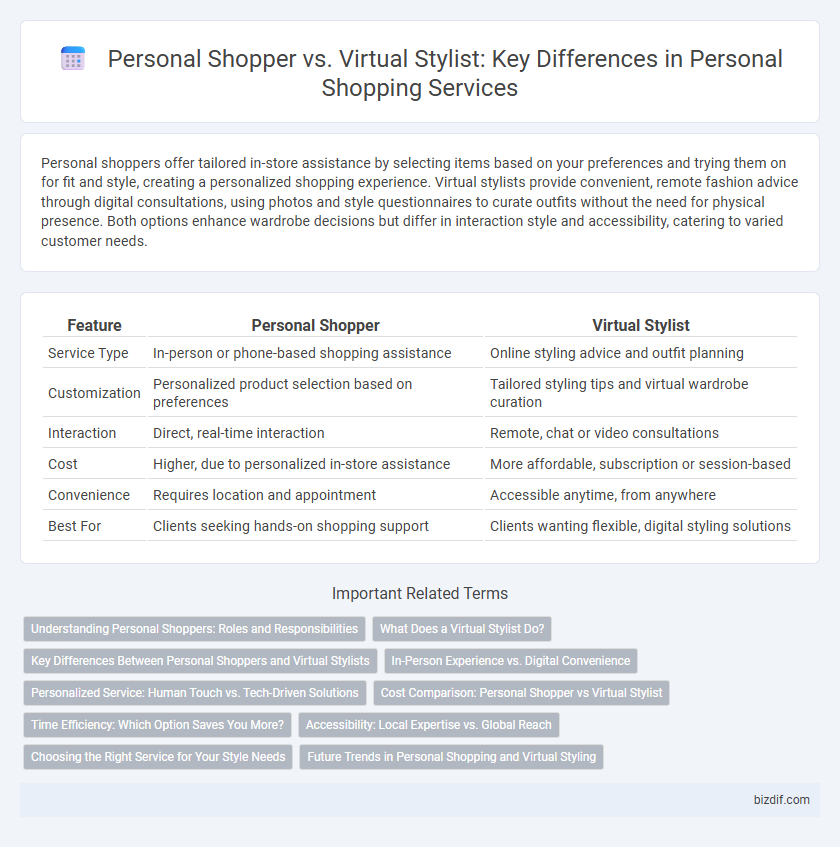Personal shoppers offer tailored in-store assistance by selecting items based on your preferences and trying them on for fit and style, creating a personalized shopping experience. Virtual stylists provide convenient, remote fashion advice through digital consultations, using photos and style questionnaires to curate outfits without the need for physical presence. Both options enhance wardrobe decisions but differ in interaction style and accessibility, catering to varied customer needs.
Table of Comparison
| Feature | Personal Shopper | Virtual Stylist |
|---|---|---|
| Service Type | In-person or phone-based shopping assistance | Online styling advice and outfit planning |
| Customization | Personalized product selection based on preferences | Tailored styling tips and virtual wardrobe curation |
| Interaction | Direct, real-time interaction | Remote, chat or video consultations |
| Cost | Higher, due to personalized in-store assistance | More affordable, subscription or session-based |
| Convenience | Requires location and appointment | Accessible anytime, from anywhere |
| Best For | Clients seeking hands-on shopping support | Clients wanting flexible, digital styling solutions |
Understanding Personal Shoppers: Roles and Responsibilities
Personal shoppers provide tailored in-person assistance by selecting and purchasing clothing and accessories based on individual client needs, preferences, and lifestyle. Their responsibilities include wardrobe analysis, personalized shopping trips, and ensuring clients achieve a cohesive and functional style. Unlike virtual stylists who offer online consultations and digital wardrobe planning, personal shoppers deliver hands-on experiences and immediate wardrobe updates.
What Does a Virtual Stylist Do?
A virtual stylist offers personalized fashion advice and wardrobe planning through online consultations, using digital tools to analyze body shape, style preferences, and current trends. They curate outfits, recommend clothing and accessories, and help clients build a cohesive wardrobe tailored to their lifestyle and goals. By leveraging technology, virtual stylists provide convenient, customized style solutions without the need for in-person appointments.
Key Differences Between Personal Shoppers and Virtual Stylists
Personal shoppers provide hands-on assistance by selecting and purchasing clothing or accessories on behalf of clients, often tailoring choices to individual tastes and occasions. Virtual stylists offer digital consultations focused on wardrobe planning, outfit coordination, and style advice through online platforms, without physically handling purchases. The key difference lies in personal shoppers managing transactions directly, whereas virtual stylists emphasize remote style guidance and personalized recommendations.
In-Person Experience vs. Digital Convenience
Personal shoppers provide a tailored in-person experience, offering hands-on assistance and immediate feedback during shopping trips that enhances personal connection and style accuracy. Virtual stylists leverage digital platforms to deliver convenience, allowing clients to access expert fashion advice and curated outfits from anywhere at any time. The choice between a personal shopper and a virtual stylist depends on preferences for tactile interaction versus flexible, technology-driven service.
Personalized Service: Human Touch vs. Tech-Driven Solutions
A personal shopper offers tailored, in-person styling advice that captures individual tastes and occasions through direct human interaction. A virtual stylist uses AI-driven tools and algorithms to provide styling recommendations remotely, analyzing user preferences and body types to create customized looks. The contrast lies in personal shoppers delivering nuanced, empathetic service while virtual stylists leverage technology for scalable, data-driven personalization.
Cost Comparison: Personal Shopper vs Virtual Stylist
Personal shoppers typically charge higher fees ranging from $100 to $300 per hour due to in-person consultations and exclusive access to luxury retailers. Virtual stylists offer more cost-effective packages, frequently priced between $50 to $150 per session, leveraging online tools and digital communication. Choosing between a personal shopper and a virtual stylist depends on budget constraints and the desired level of personalized service.
Time Efficiency: Which Option Saves You More?
A personal shopper offers tailored, in-person assistance that can save significant time by handling all shopping tasks quickly and efficiently. Virtual stylists provide convenience through online consultations and curated recommendations, minimizing the need to travel and shop physically, thus saving time in a flexible format. When prioritizing time efficiency, virtual stylists excel in speed and accessibility, while personal shoppers optimize time by managing hands-on, immediate purchases.
Accessibility: Local Expertise vs. Global Reach
Personal shoppers offer local expertise, providing personalized recommendations based on in-store availability and regional fashion trends, ensuring a tailored shopping experience within a specific geographic area. Virtual stylists leverage global reach, accessing diverse brands and fashion styles worldwide, enabling clients to explore a broader range of options beyond local limitations. This accessibility difference highlights how personal shoppers excel in hands-on, regional assistance, while virtual stylists provide convenience and variety through digital platforms.
Choosing the Right Service for Your Style Needs
Personal shoppers offer hands-on assistance by selecting and purchasing clothing tailored to your preferences, making them ideal for individuals who prefer in-person guidance and immediate wardrobe updates. Virtual stylists provide personalized fashion advice through digital consultations, perfect for clients seeking flexible, expert input without geographic limitations. Understanding your lifestyle, budget, and preferred interaction mode helps determine whether a personal shopper or virtual stylist best aligns with your style needs.
Future Trends in Personal Shopping and Virtual Styling
Personal shopping is evolving with the rise of AI-driven virtual stylists that leverage machine learning to offer hyper-personalized fashion recommendations based on individual preferences and real-time data. Future trends highlight a blend of augmented reality for virtual try-ons and sustainable shopping algorithms that prioritize eco-friendly brands and materials. Integrating social media insights and advanced analytics will further refine virtual styling, making it an indispensable tool for personalized wardrobe curation.
Personal shopper vs Virtual stylist Infographic

 bizdif.com
bizdif.com